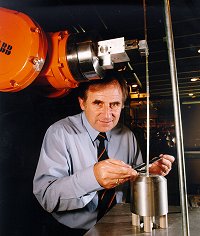[22
MAR 99] UNIVERSITY OF WARWICK PRESS RELEASE
UV Light Makes 'Impossible' ShapesResearchers at the Warwick Manufacturing Group, part of the
University of Warwick, have developed a way of creating composite materials with shapes
that have previously been impossible.
 The research enables
materials reinforced with glass fibre to find new uses in cars and construction - it could
even pave the way for making composites in space. Composite materials, with their ability
to deliver lightweight materials tailored to meet particular needs, could have many uses
but handling and assembly of materials with different properties to create composites
brings drawbacks as well as benefits particularly in processing techniques. The research enables
materials reinforced with glass fibre to find new uses in cars and construction - it could
even pave the way for making composites in space. Composite materials, with their ability
to deliver lightweight materials tailored to meet particular needs, could have many uses
but handling and assembly of materials with different properties to create composites
brings drawbacks as well as benefits particularly in processing techniques.
One obstacle with composites has been the difficulty of
joining materials. This makes it hard to create complex shapes. Warwick researchers David
Britnell and Gordon Smith have developed a process which avoids this drawback with a
technique that eliminates the need to use corner joints for complex shapes. By adapting
pultrusion techniques, the researchers can create fibre-reinforced components in complex
shapes. Two advances made this possible: the use of ultraviolet light rather than heat to
cure the resin coated fibres; and manipulation of the pultruded composite shape by a
computer controlled robot.
Dr Smith’s first idea to was to heat the materials
with a laser but found that a focused ultraviolet source provided the energy needed to
cure the composite. Pultrusion usually relies on pulling resin coated fibres through a
long heated die. The die shapes the material, creating continuous shapes, such as round
bars, angles or rectangular hollow sections. The heat from the die cures the resin as the
composite forms - but by using pultrusion and UV light rather than heat from a die to cure
the resin, they have increased the range of shapes that are open to composites.
"You can do extremely complicated shapes, for example
window frames without a joint"
says Dr Smith. As well as its ability to create new shapes,
the technology also allows manipulation of the fibres emerging from a die eg:- twisting
the fibres during the heating stage to strengthen the composite. The researchers believe
that their work could benefit many industries. In cars the composites could be an
alternative to steel and aluminium in space frames. In concrete, fibre composites could
substitute for steel reinforcement where corrosion is a hazard.
In space it might be possible to produce materials that
could be processed in orbit - in space the Sun might even provide the energy to cure the
resins.
MORE INFORMATION:
Dr Gordon Smith, Warwick Manufacturing
Group, University of Warwick,
Tel: 01203 523784 email: g.f.smith@warwick.ac.uk
Peter Dunn, University Press Officer 01203 523708
email: puapjd@admin.warwick.ac.uk
|